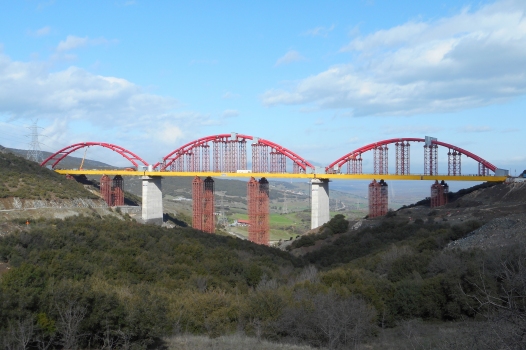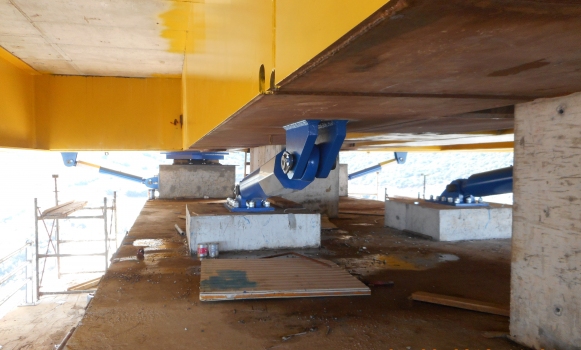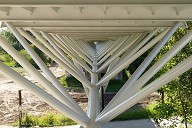Triple protection for railroad bridge in Greece
A combination of large hydraulic dampers, sliding isolation pendulums and shear keys protects the new railroad bridge SG26 in Greece against seismic-induced damages, stabilizes it against braking forces of the trains and allows for thermal movements with least possible resistance.
The SG26 has a length of approx. 300 m and rests on two steel concrete pillars. The arch bridge nearby Domokos is part of the new high-speed railroad line Tithorea – Domokos.
The technical challenge was to integrate the entire structural protection in a well-matched system on the two pillars and the abutments. In Greece, seismic protection is required per se, in addition with vibrations and loads from high-speed operation and common weather-induced movements.
Well-matched overall system
Bearings and dampers have been designed in such a manner that they achieve the required performance reliably and constantly.
The system at a glance:
-
16 hydraulic dampers dissipate the seismic energy, i.e. they convert structural movements into heat and contribute to limiting the bridge movements.
-
12 sliding isolation pendulums transmit the vertical loads, re-center the structure and protect it in case of an earthquake.
-
2 shear keys guide the bridge at the abutments in longitudinal direction.
All components have been designed in accordance with the criteria as stated in the EN15129 standard on anti-seismic devices.
Dampers respond immediately
The special feature of the hydraulic dampers type MHD is that they operate with a very low alpha value of 0.04 (characteristics: F=C*v^alpha, with C = damping constant, F= response force, v = velocity). In this way, they reduce bridge movements very efficiently since the dampers – even at low velocity – respond with high force, lock up, or ensure a large absorption of energy. When it comes to dissipation of seismic energy, it is not just about the rarely occurring severe seismic shocks but rather the dissipation of energy associated with low velocities. Such earthquakes are much more relevant in number and with regard to their impacts.
In addition, the low alpha value induces a reliable and stable response force. This protects the structure also in case the nominal velocity is exceeded – whereas an undefined increase in force caused by higher alpha could damage it.
In the service load case the hydraulic dampers respond to thermal movements with a negligibly low force without imposing load on the structure. To shock-like braking loads due to passing trains, however, the dampers respond with the necessary force to prevent the structure from movements exceeding 5 – 10 mm, which keeps the deck in position to withstand these regular dynamic force impacts in accordance with local and international standards.
Low internal pressure and a redundant sealing system ensure longevity. In total, 16 dampers were installed: on the two pillars two each in transverse direction and four each in longitudinal direction, on the abutments two each in longitudinal direction.
Sliding isolation pendulums fulfilling a quadruple task
The sliding isolation pendulums type SIP-S fulfill four important tasks in seismic isolation:
-
They transfer vertical loads.
-
They isolate the bridge deck from the pillars and allow for horizontal displacements.
-
They support the hydraulic dampers in dissipation of seismic energy.
-
They re-center the bridge deck to the center position.
Twelve SIP-S bearings have been installed, two each on the abutments, four each on the pillars. Eight of them are designed for a maximum vertical load of 37,000 kN each and allow for maximum horizontal displacements of ±316 mm.
Shear keys at the abutments
To guide the bridge in longitudinal direction, one shear key is positioned on the abutments to avoid damages due to transverse offset at the tracks. In addition a transverse offset would disturb the travelling comfort. On the pillars, however, transverse movements of the deck are possible as well, which are reduced by the hydraulic dampers.
In all bearings, MAURER has built in its MSM® high-performance sliding material. It ensures long service lifetime and stable performance of the entire structural protection system and thus protects the entire bridge structure for at least 50 years.
Work has been completed at the end of 2017. The bridge opening is scheduled for 2018.
References
Structure Types
- About this
data sheet - Product-ID
7589 - Published on:
02/05/2018 - Last updated on:
26/06/2018



 MAURER SE
MAURER SE 

